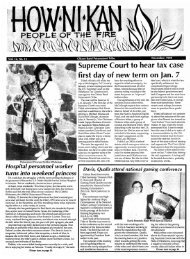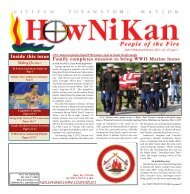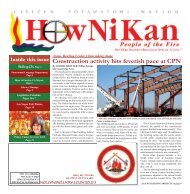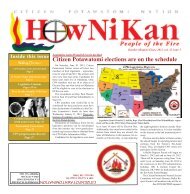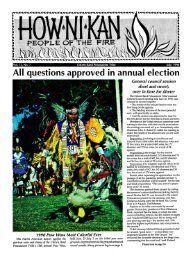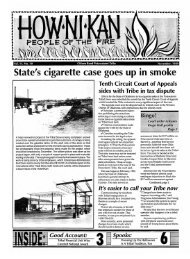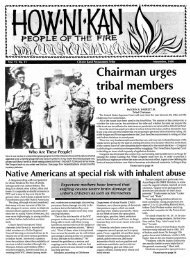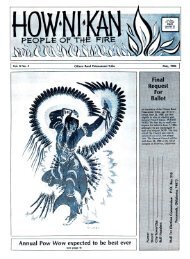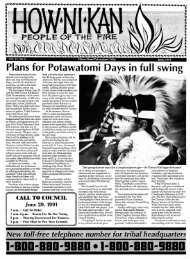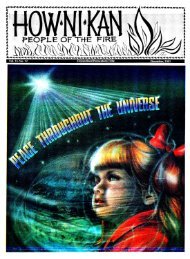November 2009 - Citizen Potawatomi Nation
November 2009 - Citizen Potawatomi Nation
November 2009 - Citizen Potawatomi Nation
Create successful ePaper yourself
Turn your PDF publications into a flip-book with our unique Google optimized e-Paper software.
16 HowNiKan <strong>November</strong> (Giwse Gises) <strong>2009</strong>, vol. 30 issue 7<br />
help our ancestors through their transition<br />
period after arriving at Sugar Creek. One<br />
of them, Sister Philippine Duchesne, along<br />
with the other two had a log cabin built; it<br />
was used as a school for the <strong>Potawatomi</strong><br />
girls.<br />
Sugar Creek has many markers erected,<br />
which include signage and 14 Stations of<br />
the Cross in the woods. Here is a photo of<br />
Station 1. I have photos of all 14. If you<br />
desire to have a copy, simply contact me<br />
by e-mail, and I will send them to you.<br />
For a wonderful write-up and more pictures<br />
on Sugar Creek, you can go to<br />
Google and search for “Sugar Creek,<br />
Kansas.” Select “Sugar Creek Mission.”<br />
The link will take you directly to the article.<br />
In the event you are ever near Paola,<br />
Kansas, I suggest you see if you can get<br />
out to Sugar Creek. The Paola Miami<br />
Museum is nearby and worth visiting.<br />
They have many artifacts from Sugar<br />
District #4 - Theresa Adame<br />
Dear <strong>Citizen</strong>s,<br />
As many of you know, October is Breast<br />
Cancer Awareness Month. I thought I<br />
would use my column this month to<br />
remind all the women to be sure to get a<br />
screening. Don't forget, men, that 1% of all<br />
breast cancer cases are diagnosed in men.<br />
I was approached recently by a friend<br />
and survivor to sit on the Brace Against<br />
Race Cancer Foundation Board. The board<br />
is attempting to reach out to educate<br />
minority women about services available<br />
Creek and several other areas our ancestors<br />
inhabited. I have included a picture of<br />
a “Clovis” hand tool that dates to around<br />
14,000 Before Christ that is in their museum.<br />
They have wagons and many antiques<br />
along with pottery shards, buttons, etc<br />
from the area.<br />
Before closing, let me again say that the<br />
book “The Last Black Robe from Indiana<br />
and <strong>Potawatomi</strong> Death March” is very factual<br />
and was used as a reference for some<br />
of the details I have included in this column.<br />
I recommend it to anyone who wants<br />
to know more about our history.<br />
I am greatly honored to be your representative<br />
and wish to serve you well. I still<br />
have e-mail addresses for only about 10%<br />
of you who reside in District #3. There are<br />
notices I send out each month about<br />
events, happenings, scholarships, HUB<br />
bids, and invitations that can only go out<br />
that way due to time constraints. If you’re<br />
not getting these notices, please send me<br />
your e-mail address, and I’ll include you in<br />
the distribution of this information.<br />
Bama Pi,<br />
Bob Whistler/B’Mashi<br />
District #3 Representative<br />
<strong>Citizen</strong> <strong>Potawatomi</strong> <strong>Nation</strong><br />
112 Bedford Road, Suite 116<br />
Bedford, TX 76022<br />
817-282-0868<br />
RWhistler@<strong>Potawatomi</strong>.org<br />
RobertMWhistler@Yahoo.com<br />
to them. I was asked as a legislator for the<br />
tribe and as a mother of two minority<br />
daughters who have a history of breast<br />
cancer in their family. Both my mother and<br />
my mother-in-law had breast cancer, so we<br />
are very aware of the need for screening.<br />
Native American women have a lower<br />
rate of cancer - 32 out of every 100,000<br />
women - compared to white women who<br />
have an instance of 112 out of every<br />
100,000. However, the five-year breast<br />
cancer survival rate is lower for Native<br />
American women than all other ethnic<br />
groups. The five-year survival rate is 49%<br />
for American Indians compared to 84% for<br />
white women. Please check out “Breast<br />
Health Online” for additional breast cancer<br />
statistics.<br />
The RABC is based in Topeka but also<br />
serves the six counties that surround<br />
Shawnee County. The guideline for a<br />
mammogram at no cost is income no more<br />
than 250% of poverty level. If you need<br />
assistance, please contact me. I will direct<br />
you where to call. We can also help with<br />
referrals after a diagnosis to get you the<br />
care you need<br />
In other news, I am moving my legislative<br />
office to Topeka in Seabrook<br />
Shopping at 20th and Gage. Look for notification<br />
in your mail of an open house. I<br />
hope to meet many of you there and see<br />
many of you again.<br />
Please send me your e-mail address to<br />
TAdame@<strong>Potawatomi</strong>.org to be added to<br />
my list for CPN updates.<br />
Theresa Adame<br />
District #5 - Gene Lambert<br />
Bozho,<br />
The seasons are upon us. Thanksgiving,<br />
Christmas, and the New Year will move in<br />
and out in the next 60 days. I tell people we<br />
should just leave the Christmas tree up all<br />
year because it goes by so quickly. What<br />
follows is “Every day is Christmas.” It<br />
really is … well, for some.<br />
We become more and more aware of our<br />
loved ones and the holidays of the past. It<br />
is a very emotional time for the best of<br />
families.<br />
I am made aware of the children in need<br />
of families and the heartache it creates for<br />
those who cannot spend that time with<br />
their biological family. There is never a<br />
direct line faring out the whys. It doesn’t<br />
matter. The pain and separation are there.<br />
It took me almost a year to get a license<br />
for foster care in the State of Arizona.<br />
Requirements will vary state to state.<br />
This is a cry for help for those who do<br />
not have a voice. They are not old enough<br />
to vote, and no one hears their cry for<br />
acknowledgement<br />
There are more than 600,000 Native<br />
American children in the foster care system<br />
today. The likelihood of a Native<br />
American child entering the system is a 2<br />
to 1 ratio.<br />
There were more than 36,000 reports of<br />
child abuse in 2006 in Arizona for foster<br />
children - and those numbers are rising.<br />
California had the top - worst - mark with<br />
more than 41,000 children entering the<br />
foster care system in one year’s time.<br />
This isn’t a story about feed-the-children-in<br />
Europe-or-Ethiopia. It is in your<br />
backyard. It is your neighbors and friends.<br />
I spoke with CPN Indian Child Welfare<br />
Program Director Janet Draper very<br />
recently, and she has been heading up a<br />
task force to bring in more Native<br />
American families to try to meet the frightening<br />
rise in numbers.<br />
If you can help, you can reach her at<br />
800-880-9880. You can also reach me at<br />
480-668-0509 or e-mail at<br />
EuniceILambert@gmail.com to learn how<br />
you can get involved. If you can help one<br />
child, we can lower the national statistics<br />
that threaten the future of our children.<br />
The following was pulled from the Pew<br />
Charitable Trust documents on Native<br />
American Foster Children in the Americas.<br />
American Indian Children<br />
Overrepresented in <strong>Nation</strong>’s Foster<br />
Care System, New Report Finds



